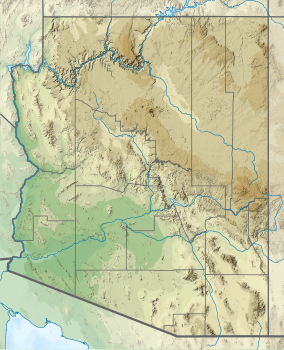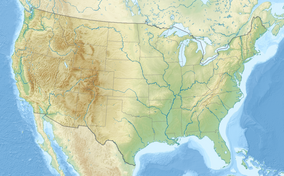Lake Mead National Recreation Area is a U.S. national recreation area in Southeastern Nevada and Northwestern Arizona. Operated by the National Park Service, Lake Mead NRA follows the Colorado River corridor from the westernmost boundary of Grand Canyon National Park to just north of the cities of Laughlin, Nevada and Bullhead City, Arizona. It includes all of the eponymous Lake Mead as well as the smaller Lake Mohave – reservoirs on the river created by Hoover Dam and Davis Dam, respectively – and the surrounding desert terrain and wilderness.[4]
| Lake Mead National Recreation Area | |
|---|---|
IUCN category V (protected landscape/seascape) | |
| Location | Clark County, Nevada and Mohave County, Arizona, United States |
| Nearest city | Boulder City and Las Vegas, Nevada |
| Coordinates | 36°00′35″N 114°47′48″W / 36.00972°N 114.79667°W |
| Area | 1,495,806 acres (6,053.31 km2)[1] |
| Established | October 13, 1936[2] |
| Visitors | 5,578,226 (in 2022)[3] |
| Governing body | Department of the Interior (DOI) National Park Service (NPS) |
| Website | Lake Mead National Recreation Area |
Formation of Lake Mead began in 1935, less than a year before Hoover Dam was completed.[4] The area surrounding Lake Mead was protected as a bird refuge in 1933[5] and later established as the Boulder Dam Recreation Area in 1936[6] and the name was changed to Lake Mead National Recreation Area in 1947.[7] In 1964, the area was expanded to include Lake Mohave and its surrounding area and became the first National Recreation Area to be designated as such by the U.S. Congress.[8]
Amenities
editLake Mead NRA features water recreation, including boating, swimming, and fishing, on both lakes as well as the stretches of river between the lakes. It also features hiking trails and views of the surrounding desert landscape.[9] Three of the four desert ecosystems found in the United States — the Mojave Desert, the Great Basin Desert, and the Sonoran Desert — meet in Lake Mead NRA. Tours of Hoover Dam – administered by the U.S. Bureau of Reclamation – are also a major attraction within the recreation area.[8][10]
About 200,000 acres (81,000 ha) of the recreation area are managed separately under the Grand Canyon-Parashant National Monument, established in 2000.[11] Water covers about 186,000 acres (75,000 ha) of the recreation area.[12]
The ghost town of St. Thomas, Nevada is contained entirely within Lake Mead NRA. The town, once entirely submerged beneath Lake Mead, features a two-mile-long loop trail with interpretative signage. It is accessed near the Northshore Entrance Station, just south of Overton.
Wilderness areas
editThere are currently nine officially designated wilderness areas under the National Wilderness Preservation System lying within Lake Mead National Recreation Area. All are in the Nevada portion. Parts of some of these wildernesses (as indicated) lie outside Lake Mead NRA and are managed by the Bureau of Land Management:[13]
- Black Canyon Wilderness (Nevada)
- Bridge Canyon Wilderness
- Eldorado Wilderness (partly BLM)
- Ireteba Peaks Wilderness (partly BLM)
- Jimbilnan Wilderness
- Muddy Mountains Wilderness (mostly BLM)
- Nellis Wash Wilderness
- Pinto Valley Wilderness
- Spirit Mountain Wilderness (partly BLM)
Park resources
edit- 900 plant species
- 500 animal species
- 24 rare and threatened species
- The relict leopard frog (Lithobates onca) is now believed to survive only in this area.[14]
- 9 designated wilderness areas
- 122,166 museum objects and archives
- 1,347 recorded archeological sites
- 23 historic structures
- 8 listed National Register Properties
- 2 Traditional Cultural Properties[8]
Fish species
editLakes Mead and Mohave offer some of the country’s best sport fishing. The following species are found in both lakes:[8]
Visitation
editFor 2012, with 6.3 million recreational visits, Lake Mead National Recreation Area was the 5th most visited national park.[8]
| Calendar Year | Annual Visits Total | Cumulative Visits | ||
|---|---|---|---|---|
| 1936 | ||||
| 1937 | 552,128 | 552,128 | ||
| 1938 | 533,914 | 1,086,042 | -18,214 | -3.30% |
| 1939 | 649,624 | 1,735,666 | +115,710 | +21.67% |
| 1940 | 668,027 | 2,403,693 | +18,403 | +2.83% |
| 1941 | 844,733 | 3,248,426 | +176,706 | +26.45% |
| 1942 | 338,778 | 3,587,204 | -505,955 | -59.90% |
| 1943 | 214,190 | 3,801,394 | -124,588 | -36.78% |
| 1944 | 263,533 | 4,064,927 | +49,343 | +23.04% |
| 1945 | 587,436 | 4,652,363 | +323,903 | +122.91% |
| 1946 | 1,165,369 | 5,817,732 | +577,933 | +98.38% |
| 1947 | 1,426,831 | 7,244,563 | +261,462 | +22.44% |
| 1948 | 1,654,004 | 8,898,567 | +227,173 | +15.92% |
| 1949 | 1,423,552 | 10,322,119 | -230,452 | -13.93% |
| 1950 | 1,798,280 | 12,120,399 | +374,728 | +26.32% |
| 1951 | 2,053,619 | 14,174,018 | +255,339 | +14.20% |
| 1952 | 1,946,706 | 16,120,724 | -106,913 | -5.21% |
| 1953 | 2,220,940 | 18,341,664 | +274,234 | +14.09% |
| 1954 | 2,112,724 | 20,454,388 | -108,216 | -4.87% |
| 1955 | 2,675,371 | 23,129,759 | +562,647 | +26.60% |
| 1956 | 2,672,774 | 25,802,533 | -2,597 | -0.10% |
| 1957 | 2,955,257 | 28,757,790 | +282,483 | +10.57% |
| 1958 | 3,190,580 | 31,948,370 | +235,323 | +7.96% |
| 1959 | 3,390,574 | 35,338,944 | +199,994 | +6.27% |
| 1960 | 2,254,185 | 37,593,129 | -1,136,389 | -33.50% |
| 1961 | 2,219,960 | 39,813,089 | -34,225 | -1.50% |
| 1962 | 2,688,745 | 42,501,834 | +468,785 | +21.10% |
| 1963 | 3,349,565 | 45,851,399 | +660,820 | +24.60% |
| 1964 | 3,462,580 | 49,313,979 | +113,015 | +3.40% |
| 1965 | 3,594,065 | 52,908,044 | +131,485 | +3.80% |
| 1966 | 3,720,485 | 56,628,529 | +126,420 | +3.50% |
| 1967 | 4,102,335 | 60,730,864 | +381.85 | +10.30% |
| 1968 | 4,751,795 | 65,482,659 | +649,460 | +15.80% |
| 1969 | 5,614,940 | 71,097,599 | +863,145 | +18.20% |
| 1970 | 4,897,135 | 75,994,734 | -717,805 | -12.80% |
| 1971 | 4,570,229 | 80,564,963 | -326,906 | -6.70% |
| 1972 | 4,888,640 | 85,453,599 | +318,407 | +6.90% |
| 1973 | 5,534,315 | 90,987,914 | +645,679 | +13.20% |
| 1974 | 5,939,533 | 96,927,447 | +405,218 | +7.32% |
| 1975 | 6,219,220 | 103,146,667 | +279,687 | +4.70% |
| 1976 | 6,948,611 | 110,095,278 | +729,391 | +11.72% |
| 1977 | 6,529,848 | 116,625,126 | -418,763 | -6.00% |
| 1978 | 6,879,870 | 123,504,996 | +350.022 | +5.30% |
| 1979 | 6,378,341 | 129,883,337 | -501,529 | -7.30% |
| 1980 | 5,145,699 | 135,029,036 | -1,232,642 | -19.30% |
| 1981 | 5,406,184 | 140,435,220 | +260,485 | +0.05% |
| 1982 | 5,565,467 | 146,000,687 | +159,283 | +3.00% |
| 1983 | 6,128,254 | 152,128,941 | +562,787 | +10.10% |
| 1984 | 6,504,206 | 158,633,147 | +375,952 | +6.10% |
| 1985 | 7,204,295 | 165,837,442 | +700,089 | +10.70% |
| 1986 | 8,034,542 | 173,871,984 | +830,247 | +11.50% |
| 1987 | 8,392,419 | 182,264,403 | +357,877 | +4.50% |
| 1988 | 8,629,895 | 190,894,298 | +237,476 | +2.83% |
| 1989 | 8,803,414 | 199,697,712 | +173,519 | +2.00% |
| 1990 | 8,893,495 | 208,591,207 | +90.081 | +1.02% |
| 1991 | 8,751,312 | 217,342,519 | -142,183 | -1.59% |
| 1992 | 9,343,549 | 226,686,068 | +592,237 | +6.80% |
| 1993 | 9,265,520 | 235,951,588 | -78,029 | -0.84% |
| 1994 | 9,913,705 | 245,865,293 | +648,185 | +7.00% |
| 1995 | 10,195,546 | 256,060,839 | +281,841 | +2.85% |
| 1996 | 9,689,997 | 265,750,836 | -505,549 | -4.96% |
| 1997 | 8,837,742 | 274,588,578 | -852,255 | -8.80% |
| 1998 | 9,106,793 | 283,695,371 | +269,051 | +3.00% |
| 1999 | 9,351,237 | 293,046,608 | +244,444 | +2.68% |
| 2000 | 9,072,545 | 302,119,153 | -278,692 | -3.00% |
| 2001 | 8,772,589 | 310,891,742 | -299,956 | -3.31% |
| 2002 | 7,824,128 | 318,715,870 | -948,461 | -10.81% |
| 2003 | 8,202,677 | 326,918,545 | +378,547 | +4.84% |
| 2004 | 8,103,609 | 335,022,154 | -99,066 | -1.21% |
| 2005 | 7,971,437 | 342,993,591 | -132,172 | -1.63% |
| 2006 | 8,059,850 | 351,053,441 | +88,413 | +1.11% |
| 2007 | 7,898,592 | 358,952,033 | -161,258 | -2.00% |
| 2008 | 7,877,581 | 366,829,614 | -21,011 | -0.27% |
| 2009 | 7,946,830 | 374,776,444 | +69,249 | +0.88% |
| 2010 | ||||
| 2011 | ||||
| 2012 | ||||
| 2013 | ||||
| 2014 | ||||
| 2015 | ||||
| 2016 | ||||
| 2017 | ||||
| 2018 | ||||
| 2019 |
See also
editReferences
edit- ^ "Listing of acreage – December 31, 2011" (XLSX). Land Resource Division, National Park Service. Retrieved December 14, 2012. (National Park Service Acreage Reports)
- ^ "Listing of National Park System Areas by State". National Park Service.
- ^ "Annual Park Ranking Report for Recreation Visits in: 2022". nps.gov. National Park Service. Retrieved July 23, 2023.
- ^ a b Crossley, John. "Lake Mead National Recreation Area". The American Southwest. Retrieved 2013-11-15.
- ^ Rothman, Hal K. (June 2002). "Balancing the Mandates: An Administrative History of Lake Mead National Recreation Area" (PDF). National Park Service.
- ^ Dodd, Douglas W. (2006-12-01). "Boulder Dam Recreation Area: The Bureau of Reclamation, the National Park Service, and the Origins of the National Recreation Area Concept at Lake Mead, 1929–1936". Southern California Quarterly. 88 (4): 431–473. doi:10.2307/41172340. ISSN 0038-3929. JSTOR 41172340.
- ^ "Lake Mead National Recreation Area: Historic Timeline". National Park Service. Retrieved 2013-11-15.
- ^ a b c d e "Press Kit: About Lake Mead National Recreation Area" (PDF). National Park Service. Retrieved 2013-11-15.
- ^ Glionna, John M. (August 27, 2015). "Enduring heat and history, hikers learn their place – far behind the ghosts of Hoover Dam". Los Angeles Times.
- ^ "Hoover Tour Information". Bureau of Reclamation. Archived from the original on 2013-11-19. Retrieved 2013-11-15.
- ^ "National Monument detail table as of April 2012" (PDF). Bureau of Land Management. Retrieved 2013-11-15.
- ^ Barnes, John. "Inventory and Monitoring of Aquatic Bird Species on Lakes Mead and Mohave 2004–2006". Digital Scholarship@UNLV. Retrieved 2013-11-15.
- ^ "Wilderness Areas in the National Park System". Wilderness.net. Retrieved 2013-11-15.
- ^ "Relict Leopard Frog". Lake Mead National Recreation Area (U.S. National Park Service). Retrieved 2020-04-26.
External links
edit- National Park Service: Lake Mead National Recreation Area
- Bureau of Reclamation: Hoover Dam
- Arizona Boating Locations Facilities Map
- Arizona Fishing Locations Map
- Where to Fish in Arizona Species Information Archived 2008-07-30 at the Wayback Machine
- Arizona Lake Levels Archived 2010-07-16 at the Wayback Machine
- Historic American Engineering Record (HAER) documentation:
- HAER No. NV-22, "Lakeshore Road, Boulder Basin, Boulder City, Clark County, NV", 30 photos, 17 data pages, 2 photo caption pages
- HAER No. NV-40, "Route No. 1–Overton–Lake Mead Road, Between Overton Beach and Park Boundary, Overton, Clark County, NV", 4 photos, 39 data pages, 2 photo caption pages
- HAER No. NV-40-A, "Route No. 1–Overton–Lake Mead Road, Culverts and Headwalls", 30 photos, 21 data pages, 6 photo caption pages
- HAER No. NV-40-B, "Route No. 1–Overton–Lake Mead Road, Gutters", 9 photos, 10 data pages, 2 photo caption pages
- HAER No. NV-40-C, "Route No. 1–Overton–Lake Mead Road, Dikes and Ditches", 6 photos, 11 data pages, 3 photo caption pages
- HAER No. NV-40-D, "Route No. 1–Overton–Lake Mead Road, Low Water Crossings", 2 photos, 4 data pages, 2 photo caption pages
- HAER No. NV-40-E, "Route No. 1–Overton–Lake Mead Road, Station Markers", 3 photos, 8 data pages, 3 photo caption pages


